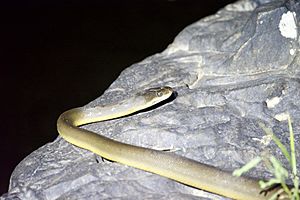Water python facts for kids
Quick facts for kids Water python |
|
|---|---|
 |
|
| Conservation status | |
| Scientific classification | |
| Genus: |
Liasis
|
| Species: |
fuscus
|
| Synonyms | |
|
|
The water python (Liasis fuscus) is a type of snake found in Australia and Papua New Guinea. It's a non-venomous python, meaning it doesn't have venom. There are no different kinds (subspecies) of water python known.
Contents
About the Water Python
A German scientist named Wilhelm Peters first described the water python in 1873. It is also sometimes called the brown water python.
What Does the Water Python Look Like?
Adult water pythons are usually about 6 to 8 feet (2 to 2.5 meters) long. Some can grow even longer, up to 10 feet (3 meters)! They are strongly built snakes.
Their head is a bit wider than their neck. They have special pits on their upper lips that can sense heat. This helps them find warm-blooded prey in the dark.
Their scales are smooth and cover their body. They have a single scale under their tail.
Color and Pattern
Water pythons are a shiny, dark blackish-brown color on their backs. This color can look like a rainbow in the light. Their bellies are a dull to bright yellow. This yellow color also covers the first few rows of scales on their sides. Their throat is a creamy color. The scales on their upper lips are light gray-brown with dark spots.
Where Do Water Pythons Live?
Water pythons live in northern Australia. You can find them in places like the Kimberley district of Western Australia. They also live in the Northern Territory and along the coast of central Queensland.
They are also found on some islands, like the Sir Charles Hardy Islands. You can also find them in Papua New Guinea, especially near the Fly River. They also live in the southern part of Indonesia's Papuan province.
The most water pythons are found on the Adelaide River floodplains in the Northern Territory.
How Do Water Pythons Behave?
Even though they are called "water pythons," many of these snakes spend most of their time away from water. They are usually active at night. During the day, they hide in places like hollow logs, riverbanks, or thick plants. If they get scared, they will usually try to escape into the nearest water.
What Do Water Pythons Eat?
Water pythons eat different kinds of animals. They are "opportunistic feeders," which means they will eat whatever they can find. A study showed that in the Adelaide River floodplains, they mostly eat dusky rats (Rattus colletti).
Water Python Reproduction
Water pythons mate in July or August. This is during the middle of the dry season. After mating, the female carries the eggs for about a month. Then, she lays about 12 eggs on average. The baby snakes hatch from the eggs after about 57 to 61 days. When they hatch, they are about 30 centimeters (12 inches) long.


